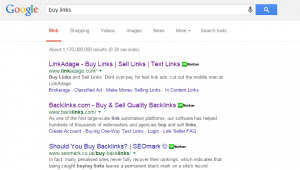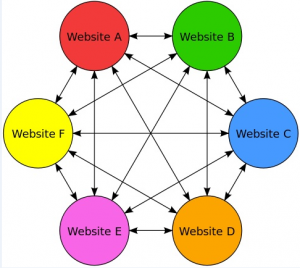Link building can be defined as a form of SEO which involves placing your link on other websites and vice versa (Duk, et al., 2013). This boosts web traffic and helps page rank.
This blog will explore 4 different ways of link exchanging and whether they are white hat or black hat. Black hat methods are short term fixes that search engines frown upon. Algorithms are becoming more savvy about showing relevant content and the consequences of using black hat linking could be a search engine ban.
Buying or selling links – Black hat
This involves exchanging money or goods/services for links or posts with certain links in. A quick google search reveals several websites offering page linking services. This is against search engine guidelines as Google prefers sites to build links by having quality content in order to keep their search results relevant (Duk, et al., 2013). Although this may be an easy and quick way to build links it will harm your websites page rank long term so avoid at all costs!
Link Farms – Black Hat
Link farms are a clique of websites that all link to other websites in the group. These are normally automated services and do not provide relevant content. Link farms are a way of bypassing search engine algorithms and to improve page rank. Link farms violate search engine guidelines and can result in penalties being imposed (SEO chat, 2015).
Online Partnerships – White Hat
Requesting links from relevant business partners can provide inbound links. It is key to find a partner with the same target market or offering a complimentary service, especially one with a high page rank itself. Search engine algorithms take more notice of links that will provide value to visitors and so this method is seen as white hat and will successfully boost page rank if done right (Bourne, 2013).
E.g. The Telegraph and Superdry. The Telegraph has provided a highly ranked inbound link to Superdry by forging a strategic partnership with them. This giveaway obviously costs Superdry more than other link building methods but would have been very successful in improving web traffic and page rank.
Linkbaiting -White Hat
Linkbaiting is the process of providing quality content that encourages links to it (Wuebben, 2012). This could be from reviews, blogs or other websites. (The Moz Blog, 2012) has identified 10 top tips for successful link baiting.
- Get influencers involved.
- Make it easy to understand.
- Give away free stuff.
- People love lists.
- Choose a highly desired topic.
- People like personalized content.
- Establish it as the go-to resource.
- Make it visually appealing.
- Segment large lists to make them readable.
- Use social share buttons.
Search engines like link-baiting because it provides natural links that add value for visitors.
A great example is Skybets ‘look busy’ campaign. It was creative and funny and therefore provide Skybet with lots of shared and inbound links. http://www.skybet.com/cms/bet_boss.shtm
Helpful points to avoid when link building – courtesy of (Anderson, 2015) &
This blog as only covered 4 types of link building and of course there are many more but it gives you an idea of what links are black hat and what search engines are looking for. I will finish up with some helpful tips.
- Avoid unnatural links
- Avoid spammy HTMLs
- Don’t include links below footers
- Avoid links from unethical or explicit websites
- Avoid irrelevant links
- Avoid repetitive links or using too many links
- Avoid purchased links
If you want to read more about building links Google provides guidelines as to what they do or do not allow here
References
Anderson, S., 2015. Free Link Building Tips For 2015. [Online]
Available at: http://www.hobo-web.co.uk/link-building-strategy-for-beginners-a-month-of-free-tips/
[Accessed 19th March 2015].
Bourne, J., 2013. Understanding Reciprocal Links and How to Use Them. [Online]
Available at: http://www.bourncreative.com/using-reciprocal-links-the-right-way/
[Accessed 19th March 2015].
Duk, S., Bjelobrk, D. & Carapina, M., 2013. SEO in e-commerce: Balancing between white and black hat methods. Opatija, IEEE.
SEO chat, 2015. Reciprocal Links: Are They Really So Bad?. [Online]
Available at: http://www.seochat.com/c/a/link-trading-help/reciprocal-links-are-they-really-so-bad/
[Accessed 18th March 2015].
The Moz Blog, 2012. 10 Extraordinary Examples of Effective Link Bait. [Online]
Available at: http://moz.com/blog/10-extraordinary-examples-of-effective-link-bait
[Accessed 19th March 2015].
Wuebben, J., 2012. Content is Currency. America: Nicholas Brealey.




